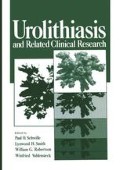Abstract
Calcium oxalate is the most frequent constituent of urinary calculi in idiopathic stone disease. Urinary excretion of both calcium (Ca) and oxalate (Ox) are recognised as risk factors1; however, there is still disagreement on the relative role played by each of the two in the genesis of urine supersaturation for CaOx. On the one hand, it has been shown that stone recurrence is related to oxalate excretion but not to calcium excretion2. On the other hand, it is widely recognized that reduction in Ca excretion (either by diet or with drugs) is highly effective in reducing the stone recurrence rate3,4, even though Ox excretion may increase. This is because intestinal calcium absorption and Ca excretion are frequently increased in CSF and the decline in urinary calcium is typically more prominent than the modest increase in urinary oxalate3. The aim of our study was to evaluate CaOx urine supersaturation in relation to either Ca or Ox excretion in a large group of idiopathic CSF in an attempt to determine if either of the two has a more relevant clinical importance.
Access this chapter
Tax calculation will be finalised at checkout
Purchases are for personal use only
Preview
Unable to display preview. Download preview PDF.
References
W. G. Robertson, M. Peacock, P. J. Heyburn, D. M. Marshall, and P. B. Clark, Br. J. Urol. 50:449 (1978).
W. G. Robertson and M. Peacock, Nephron 26:105 (1980).
C. Y. C. Pak, M. Nicar, and C. Northcutt, Contr. Nephrol. 33:136 (1982).
A. L. Straus, F. L. Coe, L. Deutch, and J. H. Parks, Am. J. Med. 72:17 (1982).
R. W. Marshall and W. G. Robertson, Clin. Chim. Acta 72:253 (1976).
A. Hodgkinson and A. Williams, Clin. Chim. Acta 36:127 (1972).
B. Baggio, G. Gambaro, S. Favaro, and A. Borsatti, Nephron 35:11 (1983).
Author information
Authors and Affiliations
Editor information
Editors and Affiliations
Rights and permissions
Copyright information
© 1985 Plenum Press, New York
About this paper
Cite this paper
Antonacci, A. et al. (1985). Calcium Oxalate (CaOx) Urine Supersaturation in Calcium Stone Formers (CSF): Hypercalciuria versus Hyperoxaluria. In: Schwille, P.O., Smith, L.H., Robertson, W.G., Vahlensieck, W. (eds) Urolithiasis and Related Clinical Research. Springer, Boston, MA. https://doi.org/10.1007/978-1-4684-7272-1_56
Download citation
DOI: https://doi.org/10.1007/978-1-4684-7272-1_56
Publisher Name: Springer, Boston, MA
Print ISBN: 978-1-4684-7274-5
Online ISBN: 978-1-4684-7272-1
eBook Packages: Springer Book Archive

